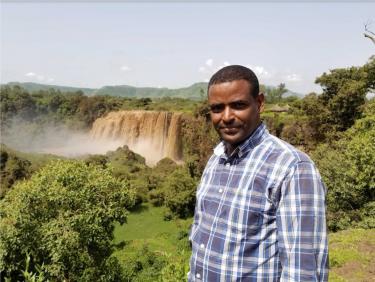Challenges for Leaders Working on Chemicals

For its March 2021 newsletter, the International Environmental Communication Association (IECA) interviewed IPEN Co-Chair Tadesse Amera about his role as an environmental communicator, why he wanted to do this work, and the challenges he has faced. In addition to his role with IPEN, Dr. Amera is a co-founder and current executive director of PAN Ethiopia, which works to advance principles of safety and sustainability in agriculture. The IECA newsletter was edited by Shirley Ho and Hanna Morris and is presented here in its entirety.
IECA: Was there a significant life experience that helped shape your attitude toward the environment? If so, what was it?
Amera: In a small town at the northwestern part of Ethiopia, I followed what my friends used to do routinely. Studying inside a small forest at the periphery of the town together with closest friends, swimming in a small river and drinking water from a natural spring that flows all year round remains at the top of my childhood memory. At the age of 19, I got my diploma in sanitary sciences from Addis Ababa University and I was assigned as a district environmental health and health education coordinator under Southern Ethiopia Health Bureau. I was the first sanitarian assigned in that district and I got reports from the countryside about incidences of waterborne diseases recurring every year. As there was no proper water supply system and noting that these areas use unprotected water sources, I started assessing the existence of natural spring water in the area where I found many. During my four years assignment in this and another district, I was able to protect more than 50 springs and the incidence of waterborne diseases in these districts declined. I am still amazed how my childhood attraction to spring water and my first work in spring protection were connected.
How did you get to your present professional position?
After the four year service under the Ministry of Health of Ethiopia, I joined Jimma University in Ethiopia and got my first degree in environmental health and worked with an NGO in integrated waste management issues. I studied integrated waste management in Germany for a year and I also rejoined Addis Ababa for two years to get my Master of Public Health (MPH). This was the juncture that gave me an opportunity to explore the human health and environmental impacts of pesticides and other hazardous chemicals in Ethiopia and beyond that needed to be addressed. In 2005, I co-founded Pesticide Action Nexus Association (PAN-Ethiopia) and became the director of the organization since then.
Working with grassroots smallholder farmers in collaboration with Pesticide Action Network UK (PAN-UK), I pioneered organic agriculture and enabled 3000 smallholder cotton farmers to produce cotton through organic means; and for 200 of them to get the first, and still the only, organic certificate for their cotton. On other hazardous chemical issues, the work I did in Ethiopia in collaboration with the International Pollutants Elimination Network (IPEN) on electrical and electronic waste (e-waste) issues has resulted in a regulation that includes the first national product Extended Producers Responsibility (EPR) provision ratified in June 2018 by the Council of Ministers of Ethiopia. Moreover, the study I lead in relation to decorative enamel paints in Ethiopia as part of the bigger campaign PAN-Ethiopia conducted with IPEN resulted in a regulation that limits the concentration of lead in Ethiopian paints to be less than 90 parts per million (PPM).
In relation to these grassroots practitioner work and my international engagement in chemical policy dialogues at the Basel Convention on transboundary movement of hazardous wastes, the Rotterdam Convention on Prior Informed Consent (PIC) on international chemical trade, the Stockholm Convention on Persistent Organic Pollutants (POPs), the Minamata Convention on Mercury and the Strategic Approach to International Chemicals Management (SAICM); my endeavor has been to link the local-with-global-and-back-to-local. This is the approach of taking local environmental problems to the global chemical policy arena and bringing global policy decisions to be nationalized and implemented at grassroots level. With this engagement, in 2018 I have been elected as IPEN Co-Chair, the highest level in the global network of over 500 public interest environmental health NGOs in more than 125 countries united to eradicate the world’s most harmful substances for a toxics-free future for all.
What made you want to be part of the IECA?
I was first introduced to IECA by my PhD supervisor, Professor Nadarajah Sriskandarajah, when I was studying at the Swedish University of Agricultural Sciences (SLU) and I got the opportunity to be part of the organizing committee of the 12th biennial COCE which was held in Uppsala in 2013 for the first time out of North America. Following this, I continued to be a member of IECA and became an elected board member for the term of 2019-2023 representing the practitioner community.
What do you think is the biggest challenge facing environmental communicators?
On the biggest challenges facing environmental communication, I see three issues from the international chemical policy dialogues perspective:
- Double standard: regulations of chemical producing countries in the North do not align the chemical trade with receiving countries in the South where these countries remain victims of chemical impacts
- Financing: A multi-trillion dollar profiting chemical industry do not contribute to the chemicals pollution related work; and this work is usually financed by the public. A 0.1% tax levy to the chemical industry earmarked to pollution control would solve a huge problem that the public and the environment are facing.
- Plastics: the issue of plastics as a WASTE management issue got some coverage and there had been few endeavors of clean-ups. However, the chemical additives in plastics that are not covered by any of the chemical conventions and the impacts of micro-plastics on aquatic and terrestrial biodiversity have not been well communicated.
